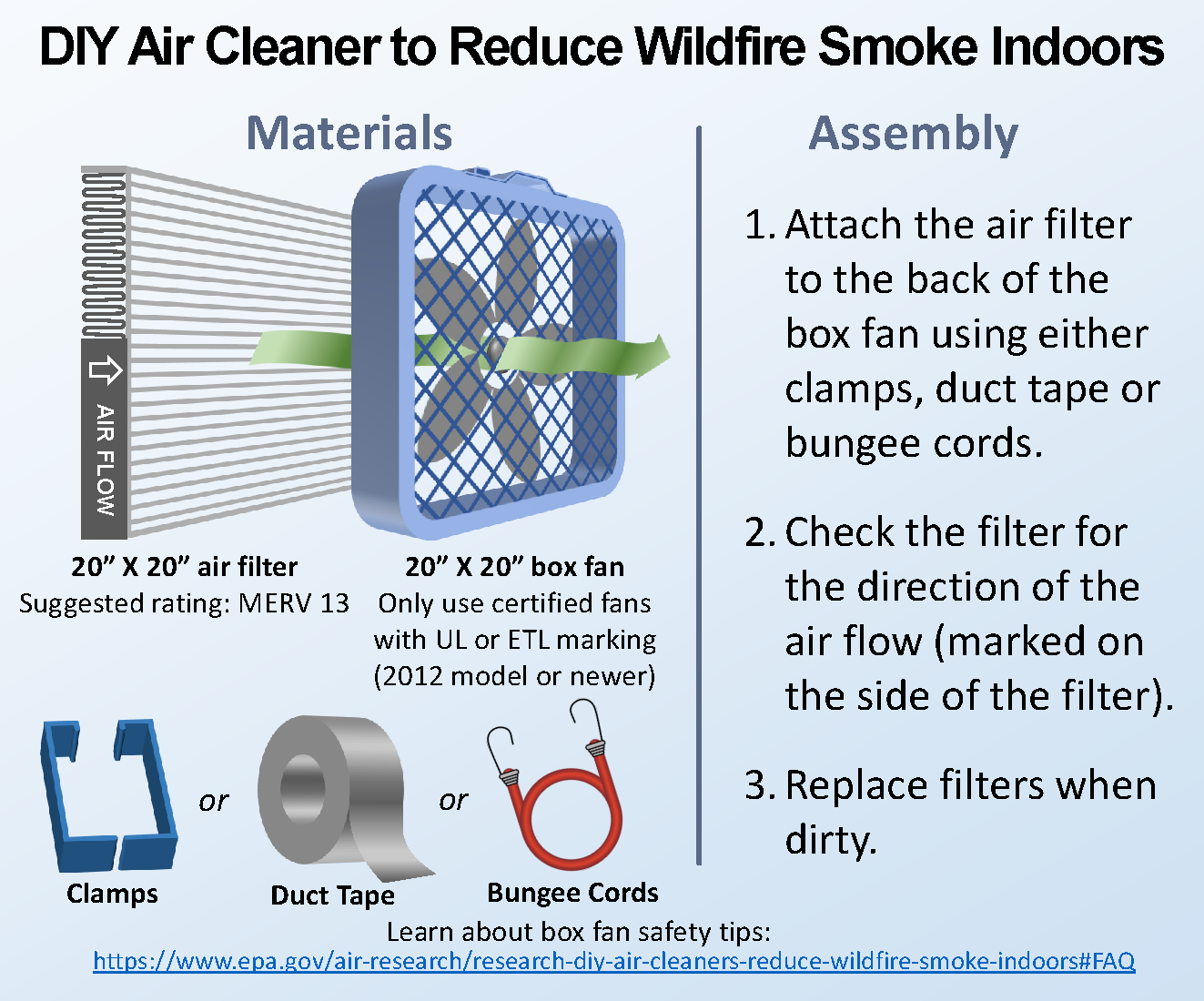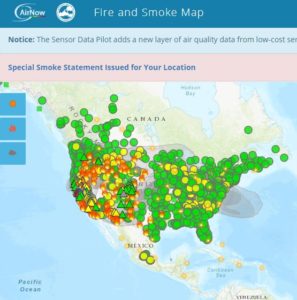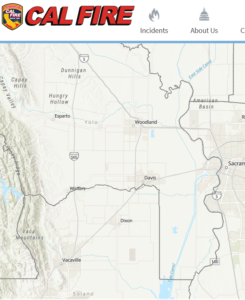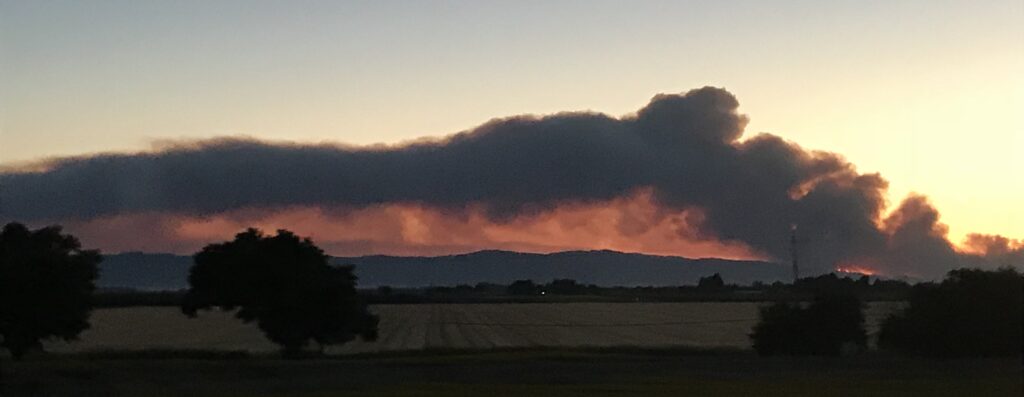
Wildfires and severe smoke affect residents of the Yolo-Solano Air Quality Management District every year. Below you will find helpful information regarding wildfires, smoke and air quality and tips to reduce exposure to harmful wildfire smoke.
Wildfire Smoke and Your Health
Smoke can affect anyone, regardless of age, fitness level or health and those most sensitive to smoke include older adults, young children, women who are pregnant, and people with heart or lung disease and asthma. Exposure to such particles can lead to short or long term health effects.
Wildfire smoke is a complex mixture of gases, such as carbon monoxide, carbon dioxide, 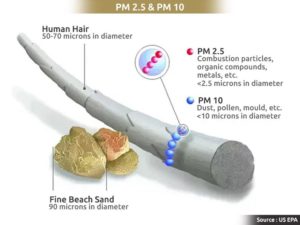 nitrogen oxide, and other organic chemicals. Smoke also consists of fine particles, called particulate matter (PM), which can vary in size from visible specks to microscopic molecules. Particulate matter is the main pollutant of concern in wildfire smoke because of the short-term exposures usually experienced by the public. These small particles can bypass the body’s natural defenses and penetrate deep into the lungs.
nitrogen oxide, and other organic chemicals. Smoke also consists of fine particles, called particulate matter (PM), which can vary in size from visible specks to microscopic molecules. Particulate matter is the main pollutant of concern in wildfire smoke because of the short-term exposures usually experienced by the public. These small particles can bypass the body’s natural defenses and penetrate deep into the lungs.
For more detailed information including suggestions for outdoor activity during wildfire smoke continue reading here.
Follow these tips to reduce exposure to harmful wildfire smoke:
-
- Limit outdoor activity. Exercise increases the amount of air lungs intake by as much as 10 to 20 times, allowing pollution to travel deeper into the lungs.
- Stay indoors. Keep windows and doors closed as much as possible.
- Run your air conditioner and check your filters. If no air conditioner is available an it is too warm stay indoors consider visiting a place with air conditioning like friends, family, the mall or local library. Do not run swamp coolers or whole house fans.
- Keep indoor air clean. Avoid smoking, burning candles, frying foods or vacuuming.
- Stay informed. Check local air quality reports at www.ysaqmd.org/ and follow the news for health warnings as well as what to do in an emergency situation.
- Check in with your health care provider. If you are having trouble breathing, seek medical assistance or call your primary care provider. People with asthma should follow their asthma management plan.
- Know your risk level. Children, older adults, women who are pregnant, and people with respiratory or heart conditions should be particularly careful to avoid exposure.
- Sign-up to receive Air Quality or Smoke Alerts by email or text through EnviroFlash.
How to develop a Clean Air Room in Your Home
- Use a portable air cleaner in one or more rooms. Portable air cleaners work best when run continuously with doors and windows closed.
- If you use a do-it-yourself box fan filtration unit, never leave it unattended.
- During periods of extreme heat, pay attention to temperature forecasts and know how to stay safe in the heat.
- Whenever you can, use air conditioners, heat pumps, fans, and window shades to keep your cleaner air space comfortably cool on hot days.
- If you have a forced air system in your home, you may need to speak with a qualified heating, ventilation, and air conditioning (HVAC) professional about different filters (HEPA or MERV-13 or higher) and settings (“Recirculate” and “On” rather than “Auto”) you can use to reduce indoor smoke.
- Avoid activities that create more indoor and outdoor air pollution, such as frying foods, sweeping, vacuuming, and using gas-powered appliances.
How to Make a DIY Air Cleaner:
Air Quality and Smoke Maps
Select the statewide fire map from CalFIRE below to open the current CalFIRE incident map. On the site you can zoom in and out using the + and – signs located at the bottom left corner and click on a fire symbol in the map to learn more information about a specific fire.
How to Use EPA Fire and Smoke Map
Fire AirNow Smoke Map-How To from Placer County Video Portal on Vimeo.
COVID-19 and Wildfire
The USDA Forest Service prepared a FAQ regarding additional considerations for managing emergency and public health response to wildfire smoke during community presence of COVID-19. That reference document is available here.
Safety After Wildfire
After a wildfire cleaning ash from our homes, businesses and public areas is an important part of cleaning the air and our community. It is important that cleanup is done safely to protect your health and the health of those around you. Once it is safe to begin cleaning, proper protection should be used avoid contact with ash, contain and properly dispose of ash and debris.
General Cleaning Tips
• Wear proper protection including protective gloves, clothing that prevent skin contact with ash and properly fitted respirator rated N-95 or P-100.
• Never use a leaf blower as it will spread the ash and blow it back into the air.
• Use household or shop vacuums with HEPA filters.
• Sweep gently then mop with damp cloth or hose lightly with water.
• Scrape ash and debris into plastic bags and dispose in the regular trash.
• Do not allow children to play in ash.
• Commercial cleaning may be needed for large-scale cleanup as well as carpet and upholstery.
Debris and Demolition Cleanup
The debris and ash from homes and structures that are damaged or destroyed by fire can contain asbestos and other hazardous materials. Ash and microscopic asbestos fibers can create serious health issues if inhaled.
YSAQMD regulates asbestos testing, surveying and removal in specific instances. To assist cleanup efforts after the LNU Lightning Complex fires, YSAQMD has developed a chart to assist in determining if the cleanup project being conducted would need to comply with these regulations. This resource is available here.
Below is information and links to assist in properly protecting yourself and disposing of these harmful materials.
Debris Removal
• Determine if Asbestos or hazardous materials are in the Debris: The District strongly recommends before disturbing or removing debris that homeowners and contractors contact and adhere to their County Environmental Health Division. Solano County residents can locate information here. Yolo County residents can locate information here.
Structures Damaged by Wildfire
• Determine if Asbestos is Present: The District strongly recommends that an asbestos survey be conducted by a Certified Asbestos Consultant prior to renovation or demolition activities.
• If Asbestos is Present: Use a California state-licensed asbestos abatement contractor to abate asbestos safely and legally. Search for a licensed contractor by zip code through the California Contractors State Licensing Board or check local telephone directory under “Asbestos Abatement and Removal.” Additionally, a list of local asbestos testing and abatement companies may be found here.
• If No Asbestos is Present: Ensure appropriate controls are in place to protect yourself and prevent dust from becoming a nuisance to the public.
• Renovation or Demolition of Commercial structures or multiple residential structures: With the exception of single residential buildings, property where structures have been damaged and future renovation/demolition activities will occur may be subject to District rules. If your structure or location is commercial, institutional, industrial or residential with multiple buildings, please contact the District before doing any renovation/demolition to ensure compliance with District Rule 9.9 which regulates asbestos removal and can be found here.
Additional Resources
Solano County Recovers
Solano County Tree Removal Information
Yolo County Office of Emergency Services
Cal OES Debris Removal Information
CalRecycle Recovery Resources for Homeowners
Emergency Generators and Public Safety Power Shutoffs (PSPS)
Backup generators aren’t for everyone. Consider safety, noise and, cost along with your  emergency power needs. Diesel exhaust contains toxic air contaminants and has been linked to lung cancer and other adverse health effects.
emergency power needs. Diesel exhaust contains toxic air contaminants and has been linked to lung cancer and other adverse health effects.
Permit and registration requirements for businesses and residents are different. Find out more below.
Additional Resources
If you would like to find additional websites with maps on air quality or weather, please click on any of the following links.
Air Quality Smoke
AirNow Real-Time AQI NASA Satellite & Smoke Plumes
Spare The Air Smoke Update >>> NOAA Hazard Mapping System
California Smoke Information >>> GOES Image Viewer on Loop
Air Quality Alerts and Social Media
It’s important to stay updated on information regarding air quality in your community. The following are some simple and easy ways to stay abreast of air quality conditions and find new or important information.
- Sign up for EnviroFlash alerts. Receive local air quality alerts and forecasts via email or text messages at http://ysaqmd.enviroflash.info/. New users can choose which monitoring site is closest to them and what types of alerts of receive.
- Follow the Air District online. Did you know the District has a Facebook and Twitter page, as well as on Nextdoor? Stay informed of local air quality issues by following us on Facebook or Twitter, and on Nextdoor.
Additional Wildfire Smoke Pages
Below are additional links to wildfire smoke pages from other local air districts or regional partners.


